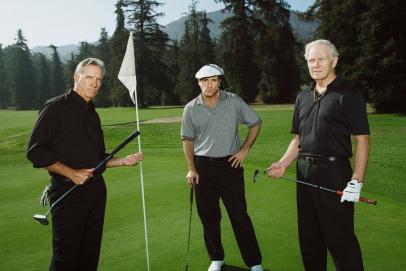senior living Shangri La
Pimp My Cart: Hot-rod culture speeds through The Villages
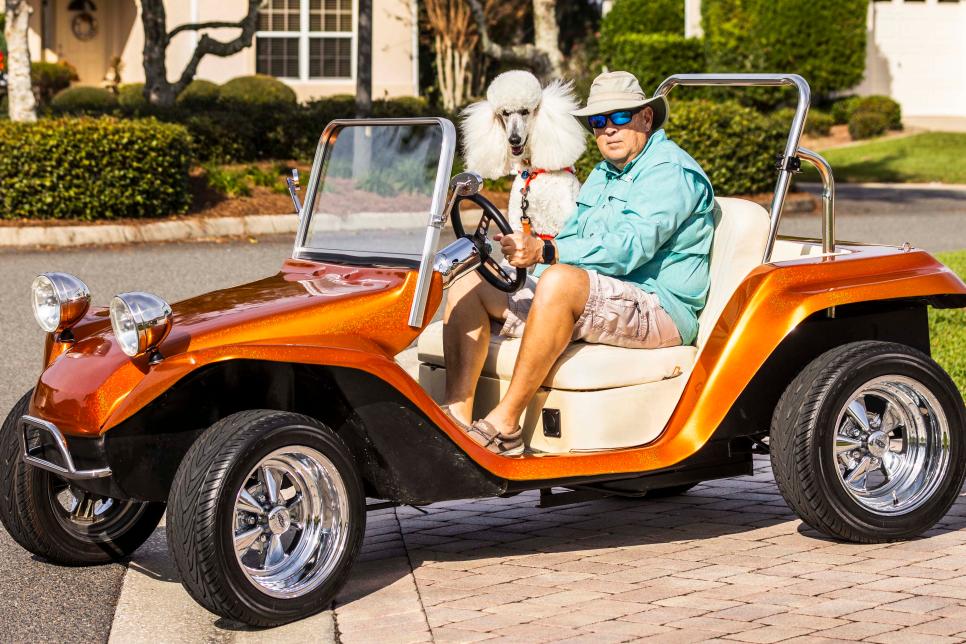
Friday night in any of The Villages’ town squares looks like Boomer spring break any time of year. High-energy cover bands crank out hits from the 1970s to the 1990s as residents spill from restaurants and bars holding light beers and umbrella drinks. The streets are lined with hundreds of almost identical E-Z- Gos, Club Cars and Yamahas parked nose-in and two across.
The scale of cart life in the famous central Florida retirement city is hard to fathom: More than 80,000 carts serve almost 150,000 people with more than 100 miles of dedicated paths and trails that access condos, villas, pickleball courts, swimming complexes, brunch and nearly 700 golf holes across 80 square miles of senior living Shangri La.
For Mike Flasch, who retired to The Villages after a career in finance at Henry Ford Health Systems in Michigan, the orderliness of the community was an obvious draw, but the monotony of the vehicle options left him cold. “When we bought our house down here, it came with a golf cart—just a regular Yamaha,” Flasch says. “Everyone’s pretty much looked the same. Maybe a different color or some different wheels, but I don’t like being like everybody else.”
Flasch did what rebellious enthusiasts have done since Henry Ford was building his own race cars in a ramshackle Dearborn garage. He got a hot rod.
Flasch’s chariot is a rolling tribute to the golden age of flathead Fords—with a two-tone silver-and-black paint job and custom bodywork that evokes a 1934 coupe right down to the polished-chrome headlight buckets. It even has a rear-facing rumble seat in the back for passengers, polished Cragar S/S muscle car wheels and 10-inch whitewall tires. Instead of 221 cubic inches of Detroit iron under the hood, Flasch has 14 Kohler horses under the front seat. He won’t lay a patch when he jumps on the gas, but his rig does come with a hitch and removable rack to hold two golf bags for when it’s time to go as off-road as things really get around The Villages.

PRETTY IN PINK: Donna Webb picks up groceries in her customized Club Car.
Andrew Hetherington

JUST CRUISIN’: Bill Pease leads members of the Custom Cart Club in his 1932 Ford-inspired cart.
Andrew Hetherington
It’s one of a line of heritage-inspired muscle carts produced by Iowa-based Pritchard Automotive and sold at its Streetrod Golf Cars dealership in The Villages. Beyond the 1934-inspired model Flasch has, you can challenge authority in versions that look like near replicas of various popular Fords from the 1920s to the ’40s. Or you can go more “modern” and choose one modeled on the classic, boxy silhouette of a 1960s Bronco. They’re all based on the same highly modified, stretched cart chassis and come with amenities like seat belts, self-canceling turn signals, brake lights and a built-in cooler under the “hood.” Prices start at about $25,000. “You can go buy a new Yamaha or something standard, load it up and spend $18,000,” says Flasch, who expects that he and his wife will go completely regular-car free when their current leases expire. “Getting something like this is more, but it’s not crazy more.”
Streetrod Golf Cars offers a virtually unlimited custom-color palette and six kinds of tops for customers willing to wait three months for a built-to-order cart, but even that level of customization doesn’t go far enough for some dedicated motorheads. Jeff Caldwell took one look at the sad-sack electric cart his mother-in-law gifted him and his wife when they moved in six years ago, and the retired Navy electronics specialist knew he needed to get to work. “I’m a fabricator and modifier kind of guy, so I harvested some lithium modules out of a Nissan Leaf electric car’s battery pack so that I’d have a cart that would go as far as I wanted,” says Caldwell, whose last street car before moving to Florida was a highly customized Shelby GT 500 pushing 590 horsepower. “That’s how it all started.”
‘I could go from one end of a football field to the other with the front wheels in the air.’—Mike Flasch
Caldwell’s latest is a ground-up build of a cart in the style of a 1957 Ford Thunderbird. “I spent a year and a half building that one—everything from hand-reaming the front spindles to custom suspension and steering so that it’s as tight as can be,” he says. Caldwell’s T-Bird follows in the true rodder tradition, carrying a collection of beautiful shapes from seemingly unrelated vehicles. “The mirrors on it are real fender mirrors from a 1963 MG. The rear brake lights are from a 1970 Camaro, and the steering column is a ’73 GM,” he says. “I have about 12 grand into it, but you couldn’t buy one like it. It’s one of a kind.”
One of the elegant synchronicities of custom cart work is that it dovetails nicely with empty nesters’ smaller real estate footprint in retirement. Caldwell has plenty of room for basic tools and carts in various stages of rehab in his garage, and if he doesn’t have a particular tool or subject-matter expertise, a Rust Belt retiree with the fabrication bonafides is usually just a cart ride away. “None of this is rocket science. They’re simple things that are fun to mess around with,” says Caldwell, who started a Villages Custom Cart Club that has swelled to more than 500 members. “One night my son-in-law and I were looking at a roofline and decided we didn’t like it. We drove it over to a friend’s who has welding stuff in his garage, and we chopped two inches off and swapped some things around. Now it has a removable top.”
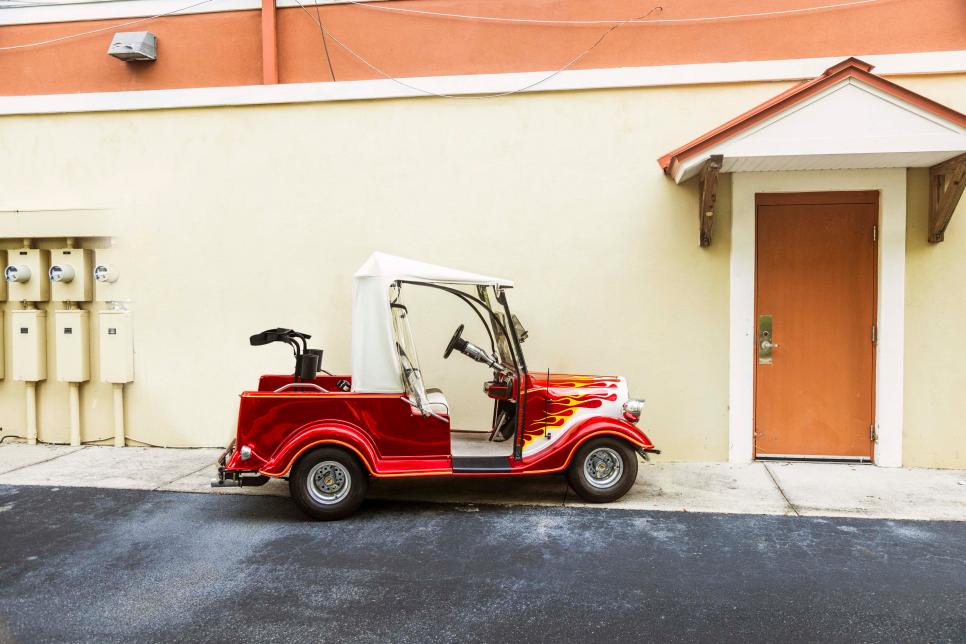
CUSTOM JOB: A built-to-order cart takes about three months at Streetrod Golf Cars.
Andrew Hetherington
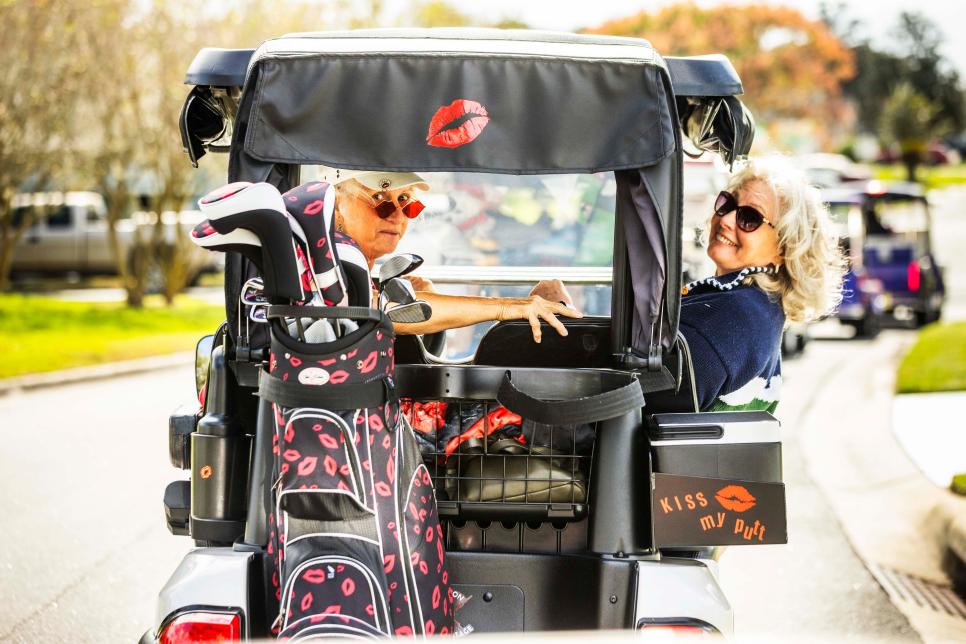
LIP OUT: Elaine Mazoch (left) and Debra Sned.
Andrew Hetherington
It’s not hard to understand why individuality would be so important in a place with as many restrictive covenants on its construction as The Villages has. When the bricks must be tan, something like, say, a flaming orange dune buggy tends to stand out. Retired defense contractor Jim Rader’s first plan upon moving south was to get an actual four-wheeling dune buggy complete with knobby tires and a tricked-out Volkswagen engine, but it wasn’t the first time his wife’s cooler head prevailed. “Her logic was that moving to a golf-cart community and buying a dune buggy didn’t make as much sense as going out and finding or building a cart version of one,” Rader says. “I found a company that had tried to make these dune buggy carts for a golf-course opening in Dubai, but they had so much custom work in them that the cost kept the company from getting off the ground.”
One of the few production models the company made—which pay homage to the iconic Meyers Manx buggies popularized by California surfers in the 1960s—happened to end up in storage near Rader’s Kansas home. “I reached out to the owner, and he wasn’t sure he wanted to sell,” says Rader, whose garage also includes a conventional cart his wife prefers for day-to-day errands and a four-seater for when guests visit. “It had been sitting since 2011, and I paid probably more than I should. But where are you going to find another one?”
‘They do have a sheriff down here who has a golf cart and a radar gun.’—Mike Flasch
More from Golf Digest
Rader had the buggy delivered to Florida and proceeded to tear it down to the frame for freshening. “We put in a new lithium battery, redid the motor—everything you would expect would need to be addressed after sitting so long,” says Rader, who owned a series of mid-’60s Chevelle Super Sports during his conventional muscle-car collecting days. “It’s the only one in The Villages, and it’s a blast to drive. We put our standard poodle in the back, and everywhere we go we get comments and people taking pictures. It’s great.”
The idea that a custom cart would be all show and no go is antithetical to hot-rod culture, but just like in the real world, it takes some finesse to get around the long arm of the law. Florida law differentiates golf carts from street-legal “low-speed vehicles” based on their top speed and installed safety equipment. Technically, a golf cart can’t go faster than 19 miles per hour, or it needs seat belts, working brake lights and regular registration and insurance, like a car.
Technically.
Taller tires and simple DIY engine tweaks can get pretty much any stock golf cart going 22 or 23 miles per hour. Other modifications, like subbing in a powertrain from a different kind of vehicle, can make it so that you can blow the doors off, literally. “I golfed with a guy a couple of years ago who said he was going to bring his cart back to Michigan for the summer and put a snowmobile engine in it,” Flasch says. Honda Clone go-kart motors are another popular choice, which turns a sedate 12-horsepower cruise into a 26-horsepower drag race.
The wheelie bars on the back of Caldwell’s T-bird are very much functional. “It’s capable of doing 50 or 60 miles per hour, and I could go from one end of a football field to the other with the front wheels in the air,” he says, hypothetically, “but with the fiberglass body, I have to be careful. I dial it back to about 18 percent.”
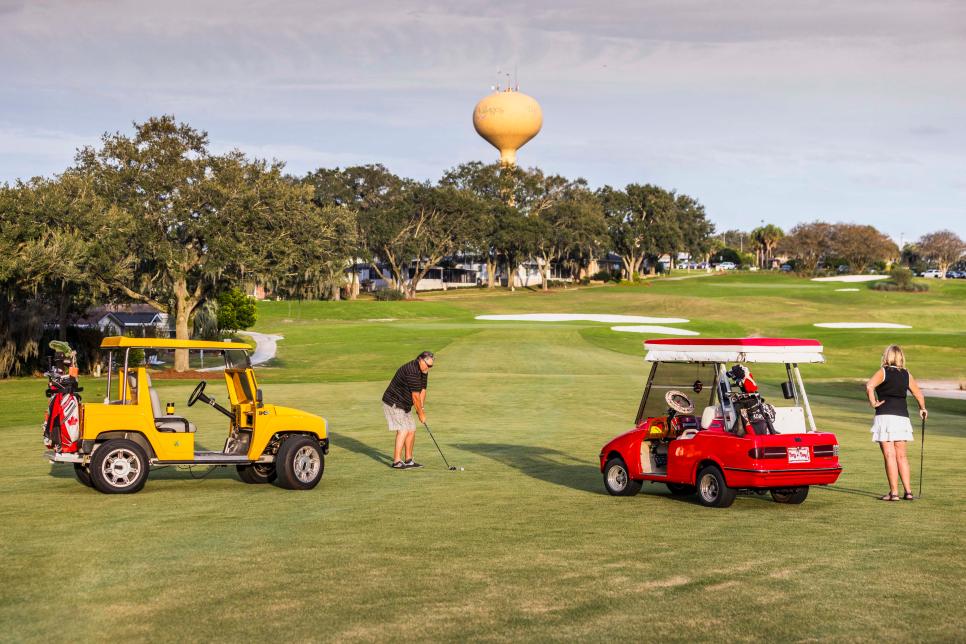
HIS AND HERS: Ken and Gwen Pozzolo take their custom wheels on the course.
Andrew Hetherington
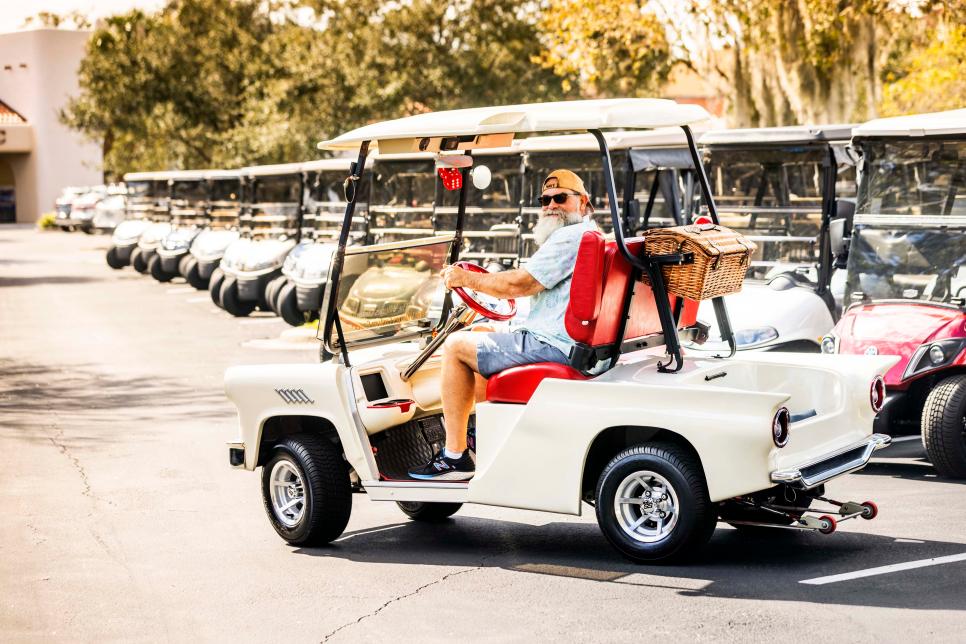
HOT WHEELS: Jeff Caldwell and his custom white T-bird.
Andrew Hetherington
After all, get too frisky with the go pedal and you risk getting popped. “They do have a sheriff down here who has a golf cart and a radar gun,” Flasch says. “He’ll sit some places and get people.”
Yep, it’s a golf cart speed trap.
Like any juicy bit of gossip, the location of the most notorious enforcement spots—such as the one in front of the Lady Lake fire station where carts often miss the speed limit change from 20 to 10—get passed around quickly. Caldwell’s T-bird goes farther with an extra level of protection you probably won’t find on the carts at your local course.
“Most of the time, I’m doing the speed limit, even though I have the capability of much more,” he says. “I do have a radar detector, just in case.”
Call it sticking it to The Man, retirement style.



